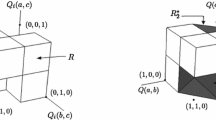Abstract
Simple majority is one of the most used decision rules in practice. However, under this decision rule, an alternative can defeat another one with very poor support. For this reason, other decision rules have been considered in the literature, such as qualified and special majorities as well as other majorities based on difference of votes. In this paper we generalize the latter mentioned voting systems by considering individual intensities of preference, and we provide some axiomatic characterizations.
Similar content being viewed by others
References
Aşan G, Sanver MR (2002) Another characterization of the majority rule. Econ Lett 75: 409–413
Barrett CR, Pattanaik PK, Salles M (1990) On choosing rationally when preferences are fuzzy. Fuzzy Sets Syst 34: 197–212
Campbell DE (1982) On the derivation of majority rule. Theory Decis 14: 133–140
Campbell DE (1988) A characterization of simple majority rule for restricted domains. Econ Lett 28: 307–310
Campbell DE, Kelly JS (2000) A simple characterization of majority rule. Econ Theory 15: 689–700
Campbell DE, Kelly JS (2003) A strategy-proofness characterization of majority rule. Econ Theory 22: 557–568
Condorcet, Marquis of (1785) Essai sur l’Application de l’Analyse à la Probabilité des Décisions Rendues à la Pluralité des Voix. L’Imprimierie Royale, Paris (English version in McLean and Urken 1995, pp 91–112)
Dutta B (1987) Fuzzy preferences and social choice. Math Soc Sci 13: 215–229
Dutta B, Panda SC, Pattanaik PK (1986) Exact choices and fuzzy preferences. Math Soc Sci 11: 53–68
Ferejohn JA, Grether DM (1974) On a class of rational social decisions procedures. J Econ Theory 8: 471–482
Fishburn PC (1973) The theory of social choice. Princeton University Press, Princeton
Fishburn PC (1983) A new characterization of simple majority. Econ Lett 13: 31–35
Garcí a-Lapresta JL (2006) A general class of simple majority decision rules based on linguistic opinions. Inf Sci 176: 352–365
Garcí a-Lapresta JL, Llamazares B (2000) Aggregation of fuzzy preferences: some rules of the mean. Soc Choice Welfare 17: 673–690
Garcí a-Lapresta JL, Llamazares B (2001) Majority decisions based on difference of votes. J Math Econ 35: 463–481
Garcí a-Lapresta JL, Martí nez-Panero M, Meneses LC (forthcoming) Defining the Borda count in a linguistic decision making context. Inf Sci. doi:10.1016/j.ins.2008.12.021
Grabisch M (2006) Representation of preferences over a finite scale by a mean operator. Math Soc Sci 52: 131–151
Herrera F, Herrera-Viedma E (2000) Linguistic decision analysis: steps for solving decision problems under linguistic information. Fuzzy Sets Syst 115: 67–82
Herrera F, Herrera-Viedma E, Verdegay JL (1995) A sequential selection process in group decision making with a linguistic assessment approach. Inf Sci 85: 223–239
Herrera F, Herrera-Viedma E, Verdegay JL (1996) A linguistic decision process in group decision making. Group Decis Negot 5: 165–176
Houy N (2007) Some further characterizations for the forgotten voting rules. Math Soc Sci 53: 111–121
Lehtinen A (2007) The welfare consequences of strategic voting in two comonly used parliamentary agendas. Theory Decis 63: 1–40
Llamazares B (2004) Simple and absolute special majorities generated by OWA operators. Eur J Oper Res 158: 707–720
Llamazares B (2006) The forgotten decision rules: majority rules based on difference of votes. Math Soc Sci 51: 311–326
Llamazares B (2007) Choosing OWA operator weights in the field of social choice. Inf Sci 177: 4745–4756
Llamazares B, Garcí a-Lapresta JL (2003) Voting systems generated by quasiarithmetic means and OWA operators. In: Fodor J, De Baets B (eds) Principles of fuzzy preference modelling and decision making. Academia Press, Ghent, pp 195–213
Llamazares B, Garcí a-Lapresta JL (2008) Extension of some voting systems to the field of gradual preferences. In: Bustince H, Herrera F, Montero J (eds) Fuzzy sets and their extensions: representation, aggregation and models. Springer-Verlag, Berlin, pp 292–310
Maskin ES (1995) Majority rule, social welfare functions and game forms. In: Basu K, Pattanaik PK, Suzumura K (eds) Choice, welfare and development. The Clarendon Press, Oxford, pp 100–109
May KO (1952) A set of independent necessary and sufficient conditions for simple majority decisions. Econometrica 20: 680–684
McLean I, Urken AB (eds) (1995) Classics of social choice. The University of Michigan Press, Ann Arbor
Miroiu A (2004) Characterizing majority rule: from profiles to societies. Econ Lett 85: 359–363
Morales JI (1797) Memoria Matemática sobre el Cálculo de la Opinion en las Elecciones. Imprenta Real, Madrid (English version in McLean and Urken 1995, pp 197–235)
Nurmi H (1981) Approaches to collective decision making with fuzzy preference relations. Fuzzy Sets Syst 6: 249–259
Nurmi H (1999) Voting paradoxes and how to deal with them. Springer-Verlag, Berlin
Nurmi H (2008) Fuzzy social choice: a selective retrospect. Soft Comput 12: 281–288
Saari DG (1990) Consistency of decision processes. Ann Oper Res 23: 103–137
Sen AK (1970) Collective choice and social welfare. Holden-Day, San Francisco
Woeginger GJ (2003) A new characterization of the majority rule. Econ Lett 81: 89–94
Woeginger GJ (2005) More on the majority rule: profiles, societies, and responsiveness. Econ Lett 88: 7–11
Yi J (2005) A complete characterization of majority rules. Econ Lett 87: 109–112
Zadeh LA (1975) The concept of a linguistic variable and its applications to approximate reasoning. Inf Sci I: 8:199–249; II: 8:301–357; III: 9:43–80
Author information
Authors and Affiliations
Corresponding author
Rights and permissions
About this article
Cite this article
Garcí a-Lapresta, J.L., Llamazares, B. Preference Intensities and Majority Decisions Based on Difference of Support Between Alternatives. Group Decis Negot 19, 527–542 (2010). https://doi.org/10.1007/s10726-009-9156-z
Received:
Accepted:
Published:
Issue Date:
DOI: https://doi.org/10.1007/s10726-009-9156-z



